| |
|
St Mary,
Barningham Winter
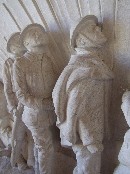 |
|
A
beautiful setting, and a beautiful name, too. The
'Winter' element comes from the family who owned
the Manor in late medieval times. This way of
naming parishes is common outside of East Anglia,
but rare here in Norfolk and Suffolk, where the
Saint dedication of the parish church or a more
utilitarian point of the compass are more usual
when differentiating between two or more parishes
with the same name. We are halfway between North
Barningham and Little Barningham here, and
another name for this parish is Barningham Town.
But there is no town, and hardly any any houses,
because this church sits in the middle of the
park of the 17th Century Barningham Hall. There
is a village on the southern edge of the park,
but it is Matlaske, which has its own parish
church. It is not possible to reach this
church directly from Matlaske, making it rather
hard to find. The old Sheringham to Aylsham road
goes through the park, but the modern road goes
around the outside, and you need to go right
around the park to the Cromer Gate on the way to
North Barningham.
|
From this
side, the church can be seen from a distance, although it
disappears beneath the rolling landscape as you approach
it. Like many Norfolk churches, it fell into disuse after
the Reformation, as the function of parish churches
changed. Simply, we didn't need so many of them. It was a
ruin by the early 17th century. This coincided with the
building of Barningham Hall, and the two facts are
probably not unconnected. However, in the early 19th
century the chancel was rescued and restored as a church,
with a small extension westwards into what had been the
nave. The gap toothed tower also survives to the west of
that, as well as what would have been the south porch,
which you still walk through to get to the church. There
is a medieval font outside under the ruined tower, which
is still used, apparently.
Georgian
Anglican churches are rare in East Anglia. Plainly, this
is not the mock-classical extravaganza which might have
been possible at such a date, and you step into an
interior which is seemly and slightly urban, with the
pre-ecclesiological feel of Catholic chapels of the
period. The westward extension contains a pretty gallery.
St Mary
has an interesting collection of medieval and continental
glass. The star of the show is a large royal arms in the
centre of the east window. These are rare, and there are
only a handful of others in East Anglia. This is to one
of the Charles's, but it is probably Charles I since it
is accompanied by other collected glass, some of which is
dated 1613. Curiously, this is the year after the Hall
was built. I think it likely that the royal arms is
pre-Commonwealth, and all were collected by an
antiquarian of the late 18th century from various sources
after Revolutions here and on the continent had removed
them from their original location.
The dated
roundels are Flemish, and depict scenes from the book of
Genesis. In one, Joseph interpets dreams in prison. The
other shows his brothers arriving in Egypt to buy corn.
There is another of good quality, depicting St Peter, but
the others are poorer, and show St Anne teaching the
Blessed Virgin to read, the Adoration of the Magi, and a
sorrowful St Peter wringing his hands as a cock crows.
The oldest
glass is at the western end of the north side. Three
tracery lights have been reset in clear quarries. One
depicts a crowned old man. The forked beard and rayed
nimbus suggests that it is God the Father. Another
depicts a beardless male Saint with a palm, and is
probably St John. These two must be 15th Century I
suppose, but the other is older, and in a quite different
style. It depicts an angel with parted hair, his wings
rising to meet behind him.
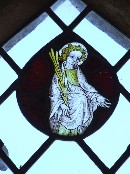 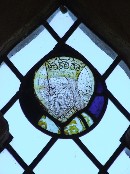 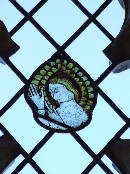
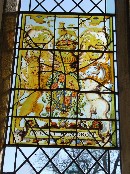
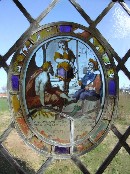 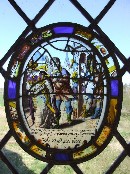 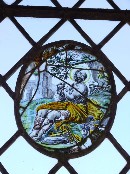
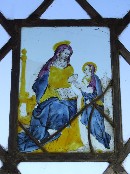 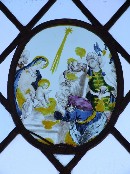
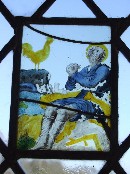
Perhaps
the most striking, not to say alarming, feature of the
church is the reredos. It is not uncommon to find a
reredos which is also the war memorial, but I have never
seen one quite like this before, with soldiers in their
WWI uniforms approaching a central cross. It is well
done, but a curious thing to focus your thoughts on every
Sunday.
One of the
Winters who gave the parish their name is depicted in
brass as a knight from the start of the 16th century, but
other memorials are to later families, the Pastons who
built the Hall, and the Motts who inherited it and had it
partly rebuilt in the decades before the church was
renewed.
| The
architect of the house rebuilding was Humphrey
Repton, who may also have been responsible for
the landscaping of the park which sets off the
ruin of the church to such good effect. St Mary is
a fascinating and slightly quirky building, and,
as if a mark of this, there is an unusual
memorial on the south wall. It remembers John
Paston, who died shortly before his first
birthday in 1729. His monument is large and
rather sombre in style, wholly secular, but the
inscription reads He just stop'd here below
on his journey to Above, and felt the Agonies of
Expiring Nature to heighten his Relish of the
Joys of Heaven. Was that intended to comfort
the grieving parents? I do not think it would
comfort me.
|
|
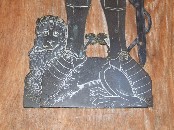 |
|
|
|
